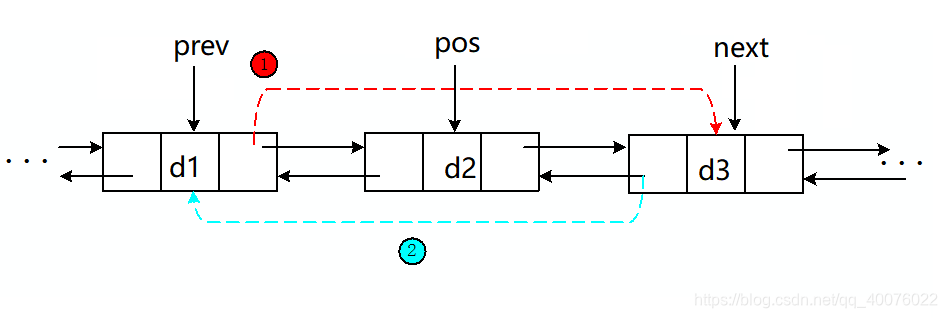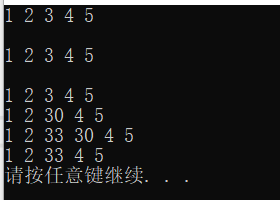C语言实现带头双向循环链表
一、双向链表的结构与实现
1.1 带头双向循环链表
结构最复杂,一般用在单独存储数据。实际中使用的链表数据结构,都是带头双向循环链表。另外这个结构虽然结构复杂,但是使用代码实现以后会发现结构会带来很多优势,实现反而简单了,后面我们代码实现了就知道了。

1.2 带头双向循环链表的实现
// 带头+双向+循环链表增删查改实现
typedef int LTDataType;
typedef struct ListNode
{
LTDataType _data;
struct ListNode* _next;
struct ListNode* _prev;
}ListNode;
二、双向链表的接口实现
2.1 创建双向链表
创建头节点,申请空间,newNode->_next = newNode->_prev = newNode;

ListNode* BuyNode(LTDataType x)
{
ListNode* newNode = (ListNode *)malloc(sizeof(ListNode));
newNode->_data = x;
newNode->_next = newNode->_prev = NULL;
return newNode;
}
// 创建返回链表的头结点.
ListNode* ListCreate()
{
ListNode* Head = BuyNode(0);
Head->_next = Head->_prev = Head;
return Head;
}
2.2 双向链表销毁
//双向链表的清除,保留头节点
void ListClear(ListNode* pHead)
{
assert(pHead);
ListNode* cur = pHead->_next;
//遍历每个节点并释放
while (cur != pHead)
{
ListNode* next = cur->_next;
free(cur);
cur = next;
}
pHead->_next = pHead->_prev = pHead;
}
// 双向链表销毁
void ListDestory(ListNode** ppHead)
{
assert(*ppHead);
ListClear(*ppHead);
free(*ppHead);
*ppHead = NULL;
}
2.3 双向链表在pos的前面进行插入

// 双向链表在pos的前面进行插入
void ListInsert(ListNode* pos, LTDataType x)
{
assert(pos);
ListNode* prev = pos->_prev; //pos的前一个结点
ListNode* newNode = BuyNode(x);
newNode->_prev = prev; //1.
prev->_next = newNode; //2.
pos->_prev = newNode; //3.
newNode->_next = pos; //4.
}
2.4 双向链表删除pos位置的节点

// 双向链表删除pos位置的节点
void ListErase(ListNode* pos)
{
assert(pos);
ListNode* prev = pos->_prev; //pos的前一个结点
ListNode* next = pos->_next; //pos的后一个节点
free(pos);
prev->_next = next; //1.
next->_prev = prev; //2.
}
2.5 双向链表打印
// 双向链表打印
void ListPrint(ListNode* pHead)
{
assert(pHead);
ListNode* cur = pHead->_next;
遍历每个节点并打印
while (cur != pHead)
{
ListNode* next = cur->_next; //next指向下一个节点
printf("%d ", cur->_data); //打印当前节点
cur = next; //cur指向下一个节点
}
printf("\n");
}
2.5 双向链表尾插

尾插其实就是在头节点的前面插入节点,因此直接调用前面写好的接口,也可以自己逐步实现
// 双向链表尾插
void ListPushBack(ListNode* pHead, LTDataType x)
{
assert(pHead);
ListInsert(pHead, x);
//ListNode* tail = pHead->_prev; //找到尾节点
//ListNode* newNode = BuyNode(x); //创建一个新节点
//tail->_next = newNode; //1.
//newNode->_prev = tail; //2.
//newNode->_next = pHead; //3.
//pHead->_prev = newNode; //4.
}
2.6 双向链表尾删
尾删就是删除双向链表的最后一个结点,删除的位置也就是头节点的前一个结点
// 双向链表尾删
void ListPopBack(ListNode* pHead)
{
assert(pHead);
ListErase(pHead->_prev);
//ListNode* tail = pHead->_prev; //找到尾节点
//if (tail == pHead) //只有头节点说明双向链表为空,直接返回
//{
// return;
//}
//ListNode* prev = tail->_prev; //尾节点的前一个节点,即新的尾节点
//free(tail); //释放尾节点
//prev->_next = pHead; //1.新的尾节点next指向head
//pHead->_prev = prev; //2.head的prev指向新的尾节点
}
2.7 双向链表头插
头插是在头节点的后面插入
// 双向链表头插
void ListPushFront(ListNode* pHead, LTDataType x)
{
assert(pHead);
ListInsert(pHead->_next, x);
}
2.8 双向链表头删
头删是删除头结点后面的元素
// 双向链表头删
void ListPopFront(ListNode* pHead)
{
assert(pHead);
ListErase(pHead->_next);
}
2.9 双向链表查找
// 双向链表查找
ListNode* ListFind(ListNode* pHead, LTDataType x)
{
assert(pHead);
ListNode* cur = pHead->_next;
while (cur != pHead)
{
ListNode* next = cur->_next;
if (cur->_data == x)
{
return cur;
}
cur = next;
}
return NULL;
}
三、代码清单
3.1 List.h
#pragma once
#include<stdio.h>
#include<stdlib.h>
#include<assert.h>
#include<windows.h>
// 带头+双向+循环链表增删查改实现
typedef int LTDataType;
typedef struct ListNode
{
LTDataType _data;
struct ListNode* _next;
struct ListNode* _prev;
}ListNode;
// 创建返回链表的头结点.
ListNode* ListCreate();
// 双向链表销毁
void ListClear(ListNode* pHead);
void ListDestory(ListNode** ppHead);
// 双向链表打印
void ListPrint(ListNode* pHead);
// 双向链表尾插
void ListPushBack(ListNode* pHead, LTDataType x);
// 双向链表尾删
void ListPopBack(ListNode* pHead);
// 双向链表头插
void ListPushFront(ListNode* pHead, LTDataType x);
// 双向链表头删
void ListPopFront(ListNode* pHead);
// 双向链表查找
ListNode* ListFind(ListNode* pHead, LTDataType x);
// 双向链表在pos的前面进行插入
void ListInsert(ListNode* pos, LTDataType x);
// 双向链表删除pos位置的节点
void ListErase(ListNode* pos);
3.2 List.c
#include "List.h"
ListNode* BuyNode(LTDataType x)
{
ListNode* newNode = (ListNode *)malloc(sizeof(ListNode));
newNode->_data = x;
newNode->_next = newNode->_prev = NULL;
return newNode;
}
// 创建返回链表的头结点.
ListNode* ListCreate()
{
ListNode* Head = BuyNode(0);
Head->_next = Head->_prev = Head;
return Head;
}
//双向链表的清除,保留头节点
void ListClear(ListNode* pHead)
{
assert(pHead);
ListNode* cur = pHead->_next;
//遍历每个节点并释放
while (cur != pHead)
{
ListNode* next = cur->_next;
free(cur);
cur = next;
}
pHead->_next = pHead->_prev = pHead;
}
// 双向链表销毁
void ListDestory(ListNode** ppHead)
{
assert(*ppHead);
ListClear(*ppHead);
free(*ppHead);
*ppHead = NULL;
}
// 双向链表打印
void ListPrint(ListNode* pHead)
{
assert(pHead);
ListNode* cur = pHead->_next;
遍历每个节点并打印
while (cur != pHead)
{
ListNode* next = cur->_next; //next指向下一个节点
printf("%d ", cur->_data); //打印当前节点
cur = next; //cur指向下一个节点
}
printf("\n");
}
// 双向链表尾插
void ListPushBack(ListNode* pHead, LTDataType x)
{
assert(pHead);
ListInsert(pHead, x);
//ListNode* tail = pHead->_prev; //找到尾节点
//ListNode* newNode = BuyNode(x); //创建一个新节点
//tail->_next = newNode; //1.
//newNode->_prev = tail; //2.
//newNode->_next = pHead; //3.
//pHead->_prev = newNode; //4.
}
// 双向链表尾删
void ListPopBack(ListNode* pHead)
{
assert(pHead);
ListErase(pHead->_prev);
//ListNode* tail = pHead->_prev; //找到尾节点
//if (tail == pHead) //只有头节点说明双向链表为空,直接返回
//{
// return;
//}
//ListNode* prev = tail->_prev; //尾节点的前一个节点,即新的尾节点
//free(tail); //释放尾节点
//prev->_next = pHead; //1.新的尾节点next指向head
//pHead->_prev = prev; //2.head的prev指向新的尾节点
}
// 双向链表头插
void ListPushFront(ListNode* pHead, LTDataType x)
{
assert(pHead);
ListInsert(pHead->_next, x);
}
// 双向链表头删
void ListPopFront(ListNode* pHead)
{
assert(pHead);
ListErase(pHead->_next);
}
// 双向链表查找
ListNode* ListFind(ListNode* pHead, LTDataType x)
{
assert(pHead);
ListNode* cur = pHead->_next;
while (cur != pHead)
{
ListNode* next = cur->_next;
if (cur->_data == x)
{
return cur;
}
cur = next;
}
return NULL;
}
// 双向链表在pos的前面进行插入
void ListInsert(ListNode* pos, LTDataType x)
{
assert(pos);
ListNode* prev = pos->_prev; //pos的前一个结点
ListNode* newNode = BuyNode(x);
newNode->_prev = prev; //1.
prev->_next = newNode; //2.
pos->_prev = newNode; //3.
newNode->_next = pos; //4.
}
// 双向链表删除pos位置的节点
void ListErase(ListNode* pos)
{
assert(pos);
ListNode* prev = pos->_prev; //pos的前一个结点
ListNode* next = pos->_next; //pos的后一个节点
free(pos);
prev->_next = next; //1.
next->_prev = prev; //2.
}
3.3 test.c
#include"List.h"
void TestList()
{
ListNode *p;
p = ListCreate();
ListPushFront(p, 5);
ListPushFront(p, 4);
ListPushFront(p, 3);
ListPushFront(p, 2);
ListPushFront(p, 1);
ListPrint(p);
ListPopFront(p);
ListPopFront(p);
ListPopFront(p);
ListPopFront(p);
ListPopFront(p);
ListPrint(p);
ListPushBack(p, 1);
ListPushBack(p, 2);
ListPushBack(p, 3);
ListPushBack(p, 4);
ListPushBack(p, 5);
ListPrint(p);
ListPopBack(p);
ListPopBack(p);
ListPopBack(p);
ListPopBack(p);
ListPopBack(p);
ListPrint(p);
//ListDestory(&p);
ListPushFront(p, 5);
ListPushFront(p, 4);
ListPushFront(p, 3);
ListPushFront(p, 2);
ListPushFront(p, 1);
ListPrint(p);
ListNode* pos = ListFind(p, 3);
pos->_data = 30;
ListPrint(p);
ListInsert(pos, 33);
ListPrint(p);
ListErase(pos);
ListPrint(p);
ListDestory(&p);
}
int main()
{
TestList();
system("pause");
return 0;
}
四、测试结果






















 954
954











 被折叠的 条评论
为什么被折叠?
被折叠的 条评论
为什么被折叠?








